3 MIN READ
Alfalfa Diseases: Symptoms and Management
April 7, 2021
Alfalfa diseases can reduce alfalfa tonnage, quality, and feeding value.
Alfalfa disease management begins with the selection of locally adapted alfalfa products that have high levels of tolerance or resistance to the prominent alfalfa diseases in the area.
Alfalfa diseases can occur when causal agents (fungi, bacteria, insects, nematodes) are present in the field, the alfalfa product is susceptible to the disease, and the environment is favorable for the disease.
Alfalfa growers have the common goal of producing high tonnage, excellent quality, and high feeding value alfalfa for their livestock or for commercial sale. Some 50 or more alfalfa diseases can compromise that goal.1 Many alfalfa products have identified levels of tolerance or resistance to some, but not all, of these diseases. Therefore, it is important to know the most prevalent alfalfa diseases within the local area and then select the best adapted products to help manage potential disease outbreaks. Crop rotation may not be a viable management option because many alfalfa disease pathogens can survive within the soil or on residue for several years.
Depending on the disease, plant infection can occur through soil water, splashing rain, wind, and possibly insect feeding. During the growing season, crop scouting should be conducted weekly to become aware of any disease development. Plant examination should be thorough as disease symptoms can mimic damage from insect feeding, herbicide burn on leaves, fertility deficiencies, environmental stress, and other issues.
Disease management is also a product of plant establishment. At planting, fields should be weed-free, well-drained, fertile, and have a pH between 6.5 and 8.0.1 To help maximize germination and stands, seeds should be treated with fungicides and be planted at a depth of 1/2 inch, regardless of soil type.2
Foliar fungicides may or may not be economical to help manage foliar diseases. The use of foliar fungicides may be the most beneficial for the first cutting each year because spring weather is more favorable for foliar alfalfa disease development, the yield potential for the first cutting is usually higher, and the growing period is usually longer for the first cutting.3 Hay price, the stage of alfalfa growth, the amount of disease development, and the cost of the fungicide must be considered to help determine if a foliar fungicide application may be warranted.
Most alfalfa diseases can be characterized by how the disease affects the plant - damping off, root rot, crown rot, and foliar diseases. However, many alfalfa diseases have a combination of symptoms.
Seedling Alfalfa Diseases
Aphanomyces Root Rot (Aphanomyces euteiches)4

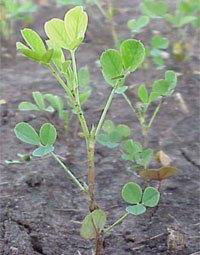
Type of Infection: Damping off and later-season root rot.
Primary time of Infection: Mid-March through May. Root rot can occur throughout growing season.
Races: Race 1 and Race 2
Symptoms:
Seedlings develop yellowish cotyledons and may be reddish on underside; seedlings may die within two to four weeks after planting.
Leaves may have bluish-green cast.
Roots are grayish or light brown, water soaked, and have reduced mass.
Plants appear stunted, yellowish, may resemble nitrogen deficiency (Figure 1).
Favorable Environment:
Saturated soils.
Warm (75 to 82°F) soils.
Management:
Select race-specific resistant products.
Avoid poorly drained fields and excessive irrigation.
Use fungicide treated seed.
Mycoleptodiscus Crown and Root Rot (Mycoleptodiscus terrestris)5


Type of Infection: Damping off and root and crown rot.
Primary time of Infection: Mid to late-summer. Can cause early-season damping off.
Symptoms:
Plants appear stunted and yellow.
Lateral and fibrous roots are reduced.
Existing roots may be black and rotted.
Crown branches are rotted.
Crown interior is brown with a black margin and decayed from crown into taproot (Figure 2).
Black sclerotia present in the root and on surface of rotted crown.
Favorable Environment:
Overwinters as sclerotia in residue and soil.
Seedling damping off can occur when temperatures are very warm (mid-80s).
Management:
No resistance available.
Sclerotia can persist in soil for many years making crop rotation unreliable for management.
Can infect other legume species including: birdsfoot trefoil, white clover, alsike clover, red clover, crimson clover, and soybean.
Fungicide treated seed may or may not be effective.
Phytophthora Damping Off and Root Rot (Phytophthora megasperma)6,7,8


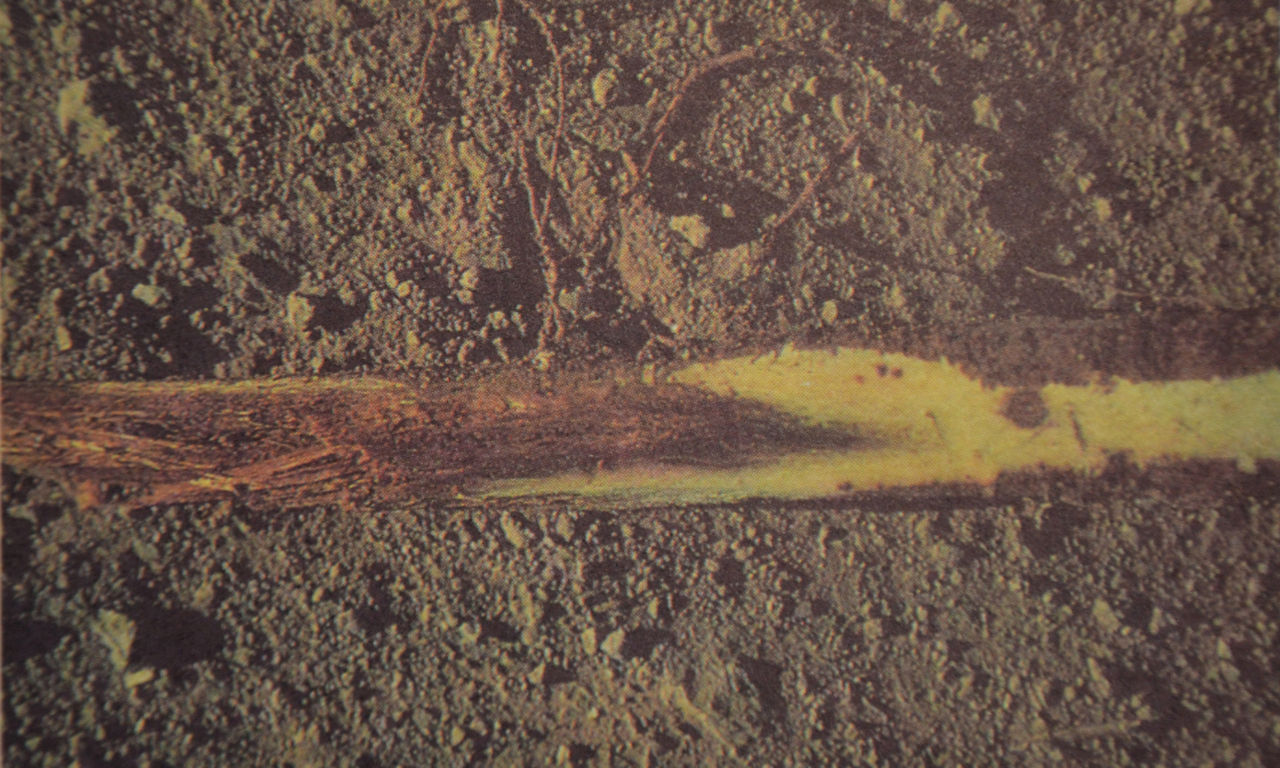
Type of Infection: Seedling damping off and root rot.
Primary time of Infection: Mid-March through May. Can infect anytime during the growing season.
Symptoms:
Seedlings fail to emerge or die soon after emergence.
Plants appear stunted, yellow or reddish-purple lower leaves, may be wilted.
Taproots have tan to brown or red-brown to black lesions and can be rotted just below crown (Figure 3).
Infected plants can be easily pulled from soil.
Favorable Environment:
Wet soils and cool temperatures.
Survives in soil for many years.
Greatest problem in poorly drained soils with high organic matter.
Management:
Select resistant products and consider planting at a higher seeding rate.
Avoid poorly drained fields and excessive irrigation.
Improve drainage and manage compaction.
Use fungicide treated seed.
Pythium (Pythium spp.)6

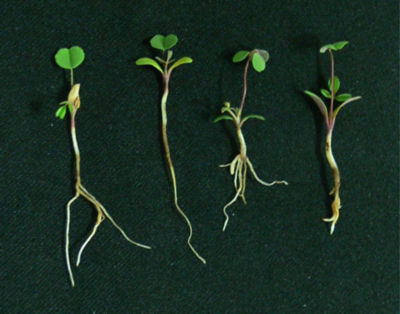

Type of Infection: Damping off.
Primary time of Infection: Mid-March through May.
Symptoms:
Seedlings fail to emerge or die soon after emergence.
If emergence occurs, plants appear stunted, yellowish, may be wilted.
Roots appear water soaked, mushy, rotted (Figure 4).
Can infect mature plants with rotting of fine roots (Figure 5).
Favorable Environment:
Wet soils and cool temperatures.
Survives in soil for many years.
Greatest problem in poorly drained soils with high organic matter.
Management:
Select resistant products and consider planting at a higher seeding rate.
Avoid poorly drained fields and excessive irrigation.
Use fungicide treated seed.
Rhizoctonia (Rhizoctonia spp.)9

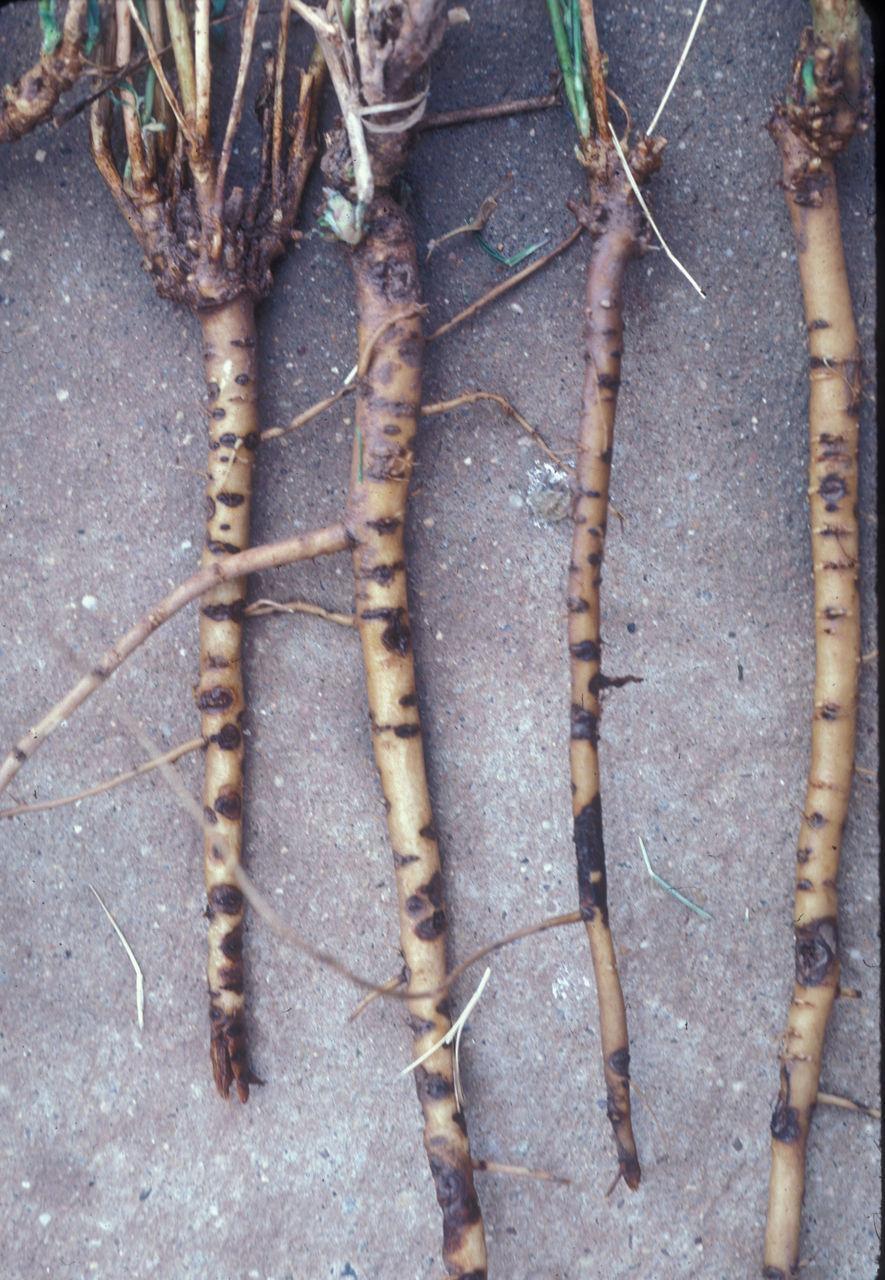
Type of Infection: Seedling damping off, root rot, crown and stem rot, and foliar.
Primary time of Infection: Can infect anytime during the growing season.
Symptoms:
Seedlings fail to emerge or die soon after emergence.
Tan, sunken, and elliptical lesions develop on taproot where lateral roots emerge (Figure 6).
During the winter, existing root lesions turn black.
Roots are girdled during the summer.
Infected crowns appear dark brown to black.
Lower portion of stems develop light brown cankers.
Leaves wilt, turn yellow, may turn reddish, and dead leaves stick together.
Plants may collapse into a water-soaked, light-brown mass.
Cobwebby strands may develop on leaves.
Favorable Environment:
Wet soils and high temperatures.
Survives in soil for many years.
Greatest problem in poorly drained soils with high nitrogen-organic matter (plowed under sod or manure spread during warm, humid weather).
Management:
Select adapted alfalfa products.
Avoid poorly drained fields and excessive irrigation.
Harvest no later than first flower.
Avoid crown injury that can be caused by grazing or equipment crossing wet soils.
Root Rots
Bacterial Wilt (Clavibacter michiganense subsp. insidiosum)10


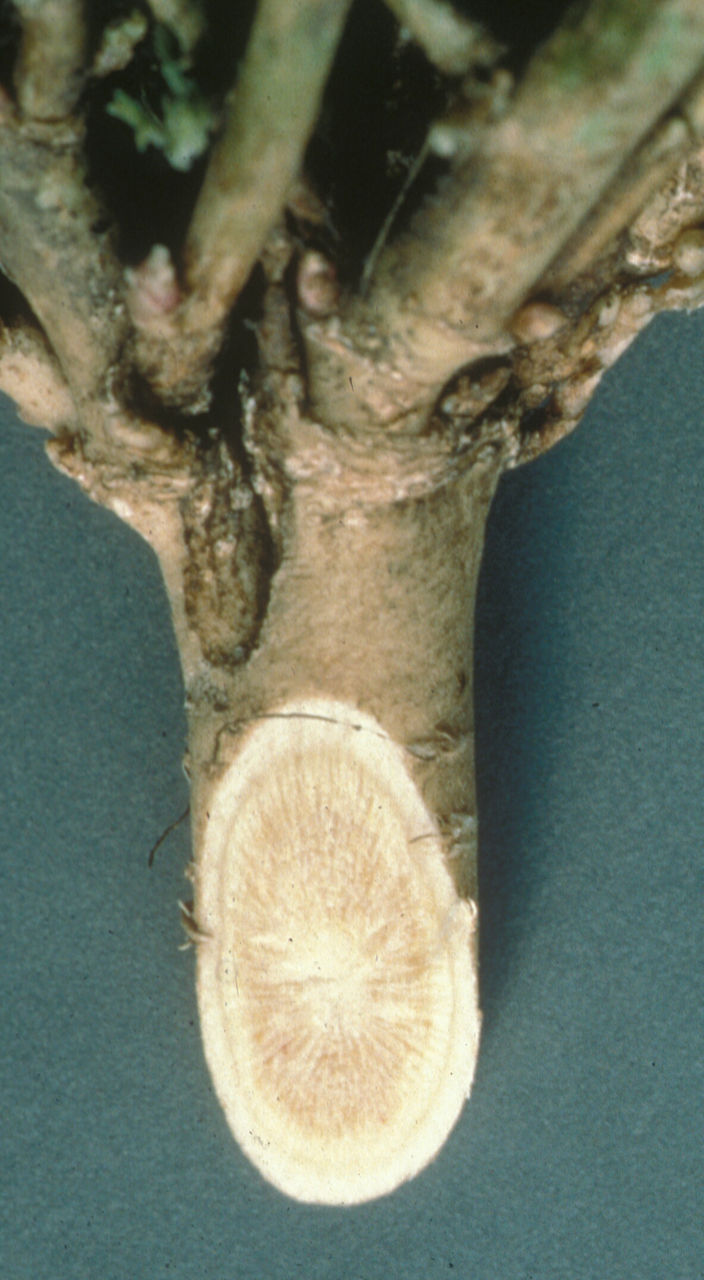
Type of Infection: Root rot.
Primary time of Infection: Established alfalfa stands of three years or older.
Symptoms:
Stunted plants have many spindly, shortened stems and small, light green to yellow leaflets (Figure 7).
Outer vascular taproot tissue becomes yellow to dark golden brown (Figure 8).
Leaves may be cupped.
Plants may wilt during the day and recover at night.
Favorable Environment:
Wet soils and cool temperatures.
Survives in crop residue.
Enters plants through wounds.
Management:
Select resistant products.
Rotate crops.
Avoid poorly drained fields and excessive irrigation.
Avoid mowing when wet.
Harvest first-cutting at late-bud and every 30 to 40 days thereafter.
Clean equipment before leaving field.
Improve drainage and manage compaction.
Fusarium Wilt (Fusarium oxysporum f. sp. medicaginis)11


Type of Infection: Root rot.
Primary time of Infection: Established alfalfa stands of two years or older.
Symptoms:
Scattered, wilted plants are first evidence.
One side of the stem may wilt and die or whole plant may be affected.
Stems and leaves appear bleached (Figure 9).
Leaves wilt during the day and regain turgidity at night.
Outer layer of taproot initially develops brown to brick red streaks, finally surrounds taproot, then dies.
Favorable Environment:
Survives in soil and residue for many years.
Enters plants through wounds.
More severe if root-knot nematodes are present.
Management:
Select resistant products resistant to root-knot nematode and Fusarium Wilt.
Phytophthora Root Rot (Phytophthora megasperma)6,7,8



Type of Infection: Seedling damping off and root rot.
Primary time of Infection: Mid-March through May. Can infect anytime during the growing season.
Symptoms:
Seedlings fail to emerge or die soon after emergence.
Plants appear stunted, yellow or reddish-purple lower leaves, may be wilted.
Taproots have tan to brown or red-brown to black lesions and can be rotted just below crown (Figure 3).
Infected plants can be easily pulled from soil.
Favorable Environment:
Wet soils and cool temperatures.
Survives in soil for many years.
Greatest problem in poorly drained soils with high organic matter.
Management:
Select resistant products and consider planting at a higher seeding rate.
Avoid poorly drained fields and excessive irrigation.
Improve drainage and manage compaction.
Use fungicide treated seed.
Rhizoctonia Root Rot (Rhizoctonia spp.)9


Type of Infection: Seedling damping off, root rot, crown and stem rot, and foliar.
Primary time of Infection: Can infect anytime during the growing season.
Symptoms:
Seedlings fail to emerge or die soon after emergence.
Tan, sunken, and elliptical lesions develop on taproot where lateral roots emerge (Figure 6).
During the winter, existing root lesions turn black.
Roots are girdled during the summer.
Infected crowns appear dark brown to black.
Lower portion of stems develop light brown cankers.
Leaves wilt, turn yellow, may turn reddish, and dead leaves stick together.
Plants may collapse into a water-soaked, light-brown mass.
Cobwebby strands may develop on leaves.
Favorable Environment:
Wet soils and high temperatures.
Survives in soil for many years.
Greatest problem in poorly drained soils with high nitrogen-organic matter (plowed under sod or manure spread during warm, humid weather).
Management:
Select adapted alfalfa products.
Avoid poorly drained fields and excessive irrigation.
Harvest no later than first flower.
Avoid crown injury that can be caused by grazing or equipment crossing wet soils.
Crown and Stem Rots
Anthracnose (Colletotrichum trifolii)12

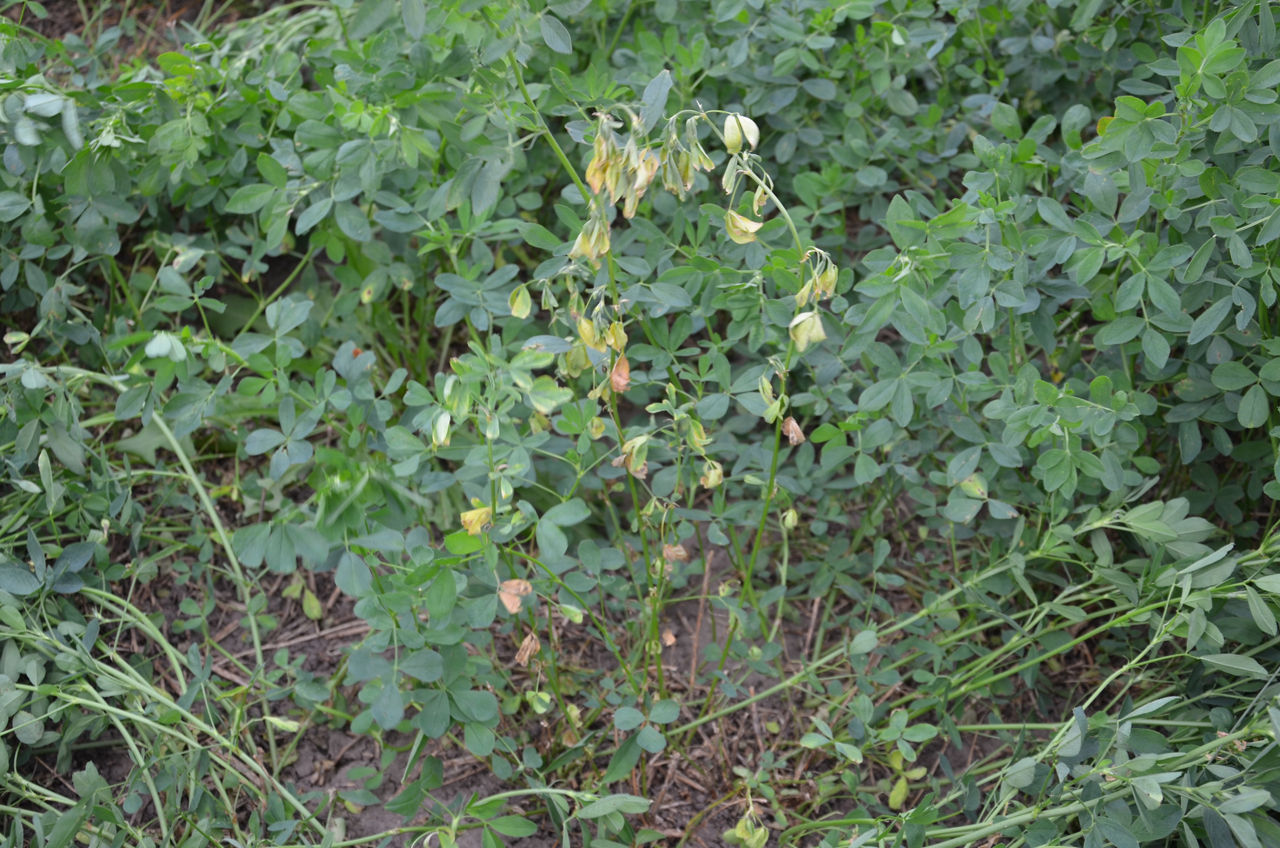
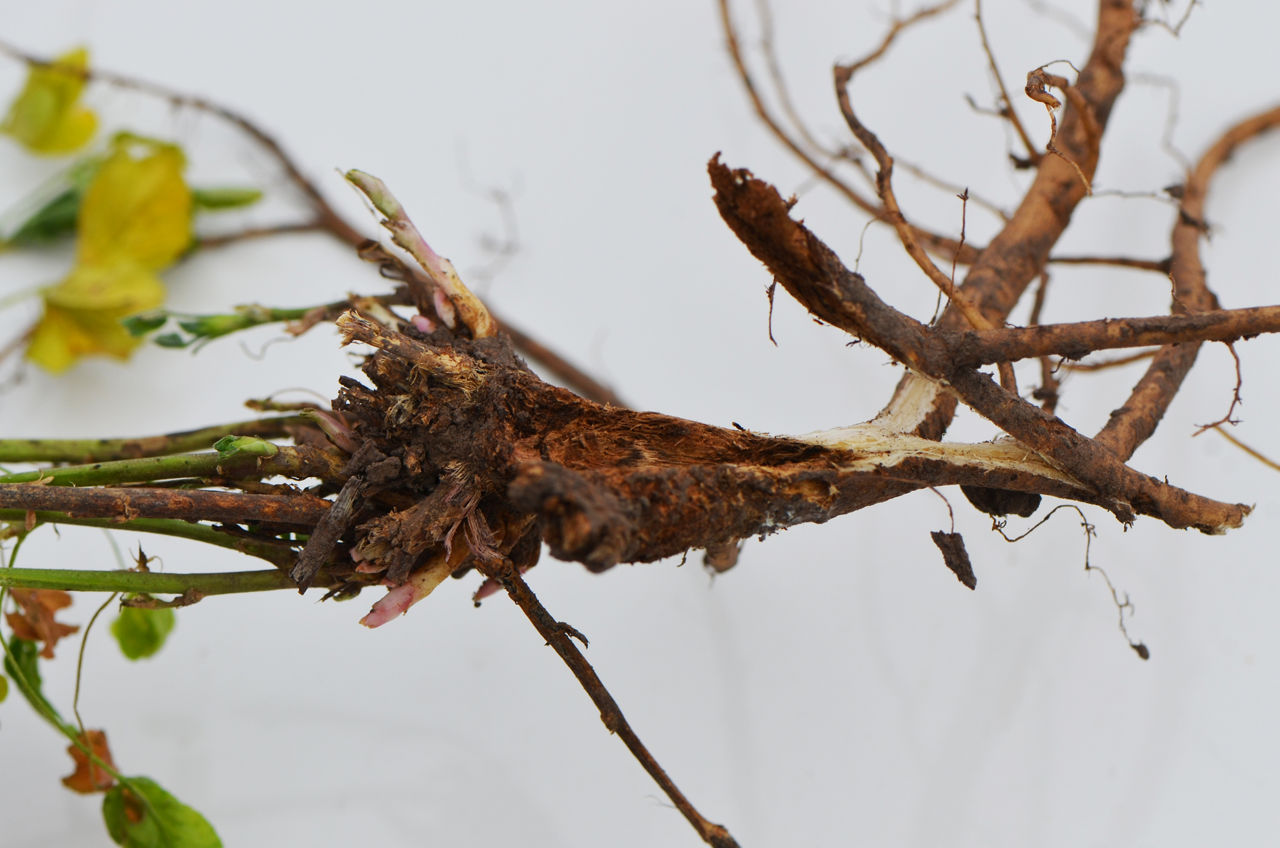
Type of Infection: Crown rot, stem rot, and foliar leaf spot.
Primary time of Infection: Can occur throughout the growing season but most noticeable after second cutting and on stands two or more years old.
Symptoms:
Stem tips wilt and bend forming a “shepherd’s crook” (Figure 10).
Diamond shaped, ash-gray lesions with dark-brown to purple borders develop on lower stems.
Lesions may girdle the stem causing plants to wilt, drop leaves, and have straw-colored shoots.
Infected crowns are bluish-black near stem origins and reddish-brown near inner crown tissues (Figure 11).
Favorable Environment:
Warm, humid conditions late in the growing season.
Management:
Select resistant products.
Harvest when plants are “young”.
Rotate out of alfalfa for one or more years.
Clean equipment before moving into other fields.
Sclerotina Crown and Stem Rot (Primary - Sclerotinia trifoliorum, Secondary - Sclerotinia sclerotiorum)11,13

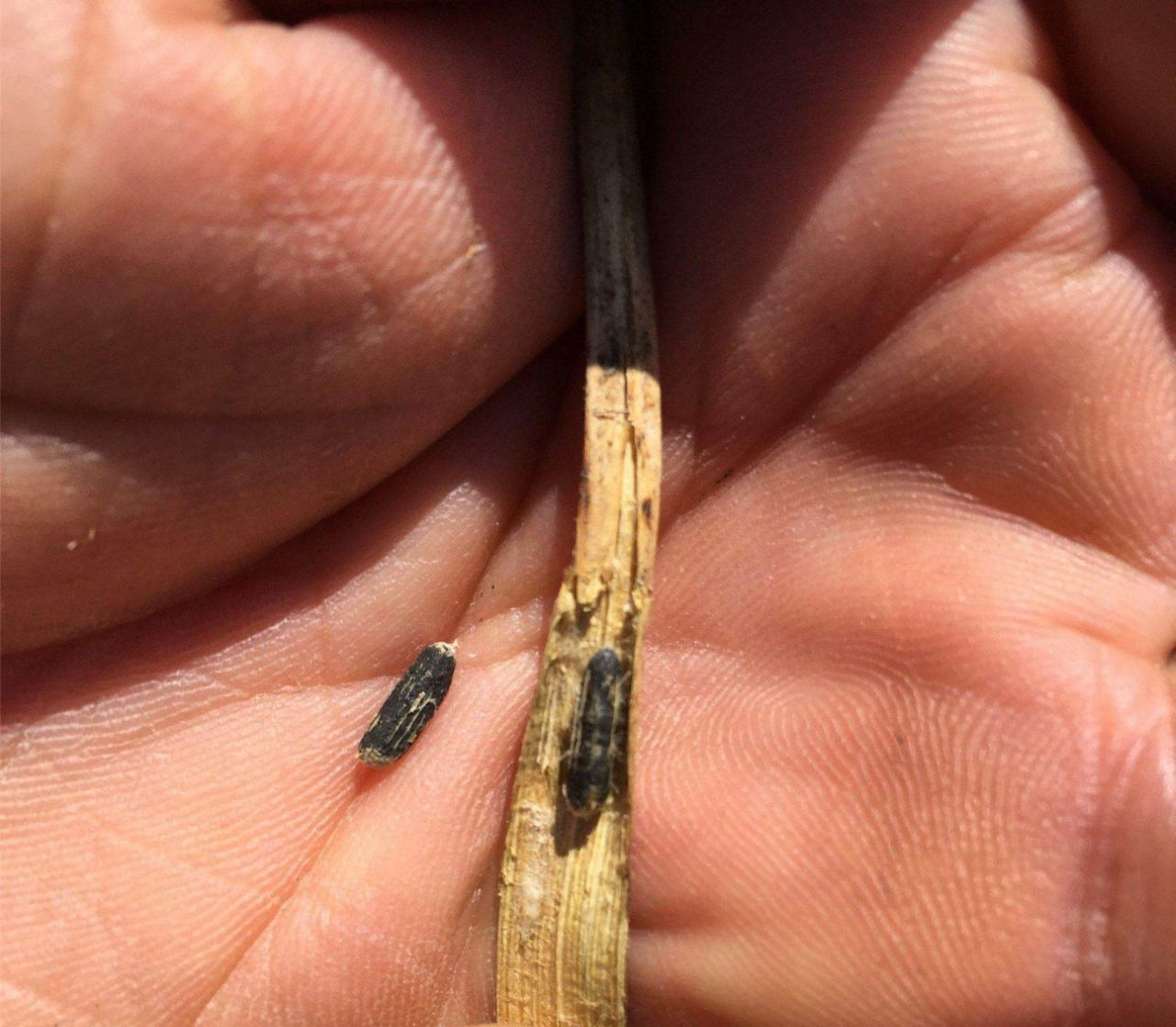
Type of Infection: Crown and stem rot.
Primary time of Infection: Early spring and late fall.
Symptoms:
White fluffy mass grows on plants or soil surface and infects plants as the mass grows.
Seedlings most vulnerable.
Fungus forms small, hard black sclerotia in or on the plant (Figure 12).
Favorable Environment:
Cool and wet.
Management:
Select tolerant products.
Rotate out of alfalfa; however, sclerotia can remain viable in soil for many years.
If possible, avoid planting into infected fields.
Avoid seeding in the fall.
Clean equipment before moving into other fields.
Foliar and Stem Rot
Bacterial Leaf Spot (Xanthomonas campestris subsp. alfalfae)14

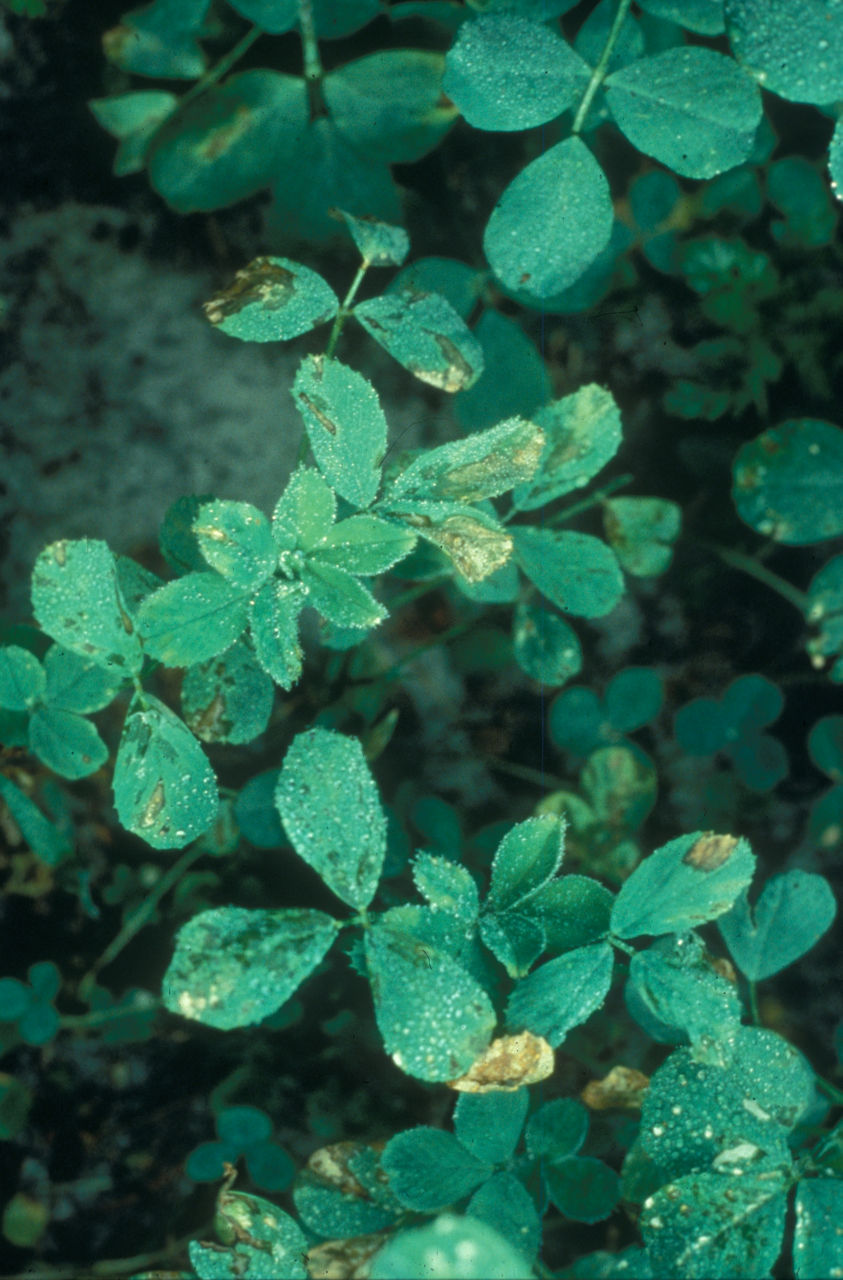
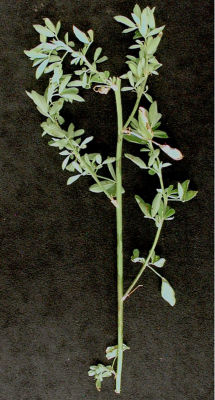
Type of Infection: Foliar and stem rot.
Primary time of Infection: Mid-summer, but common in early fall and late-summer.
Symptoms:
Tiny circular water-soaked lesions on lower leaf surface which become translucent or tan and shiny (Figure 13).
Stem lesions are initially water-soaked and “greasy” then turn light to dark brown or black (Figure 14).
Considerable stand loss can occur.
Favorable Environment:
Wet, hot (82 to 90°F), and windy.
Spread by wind and rain.
Survives winter in residue.
Management:
Select resistant pathogen-free products.
Spring Black Stem and Leaf Spot (Phoma medicaginis var. medicaginis)14,15


Type of Infection: Foliar and stem rot.
Primary time of Infection: Early spring.
Symptoms:
Irregular small, dark brown to black spots on lower leaves, petioles, and stems appear in early spring (Figure 15).
Leaves turn yellow and wither before falling.
Stem and petiole lesions can girdle and blacken large areas near base of plant.
Fungus can infect crown and upper root.
Stems are brittle and easily snapped.
Favorable Environment:
Cool, moist conditions.
Survives winter in residue.
Spreads by splashing rain, wind, and insects.
Management:
Cut early if leaf drop becomes excessive.
First harvest is usually the most affected.
Summer Black Stem (Cercospora medicaginis)14,15

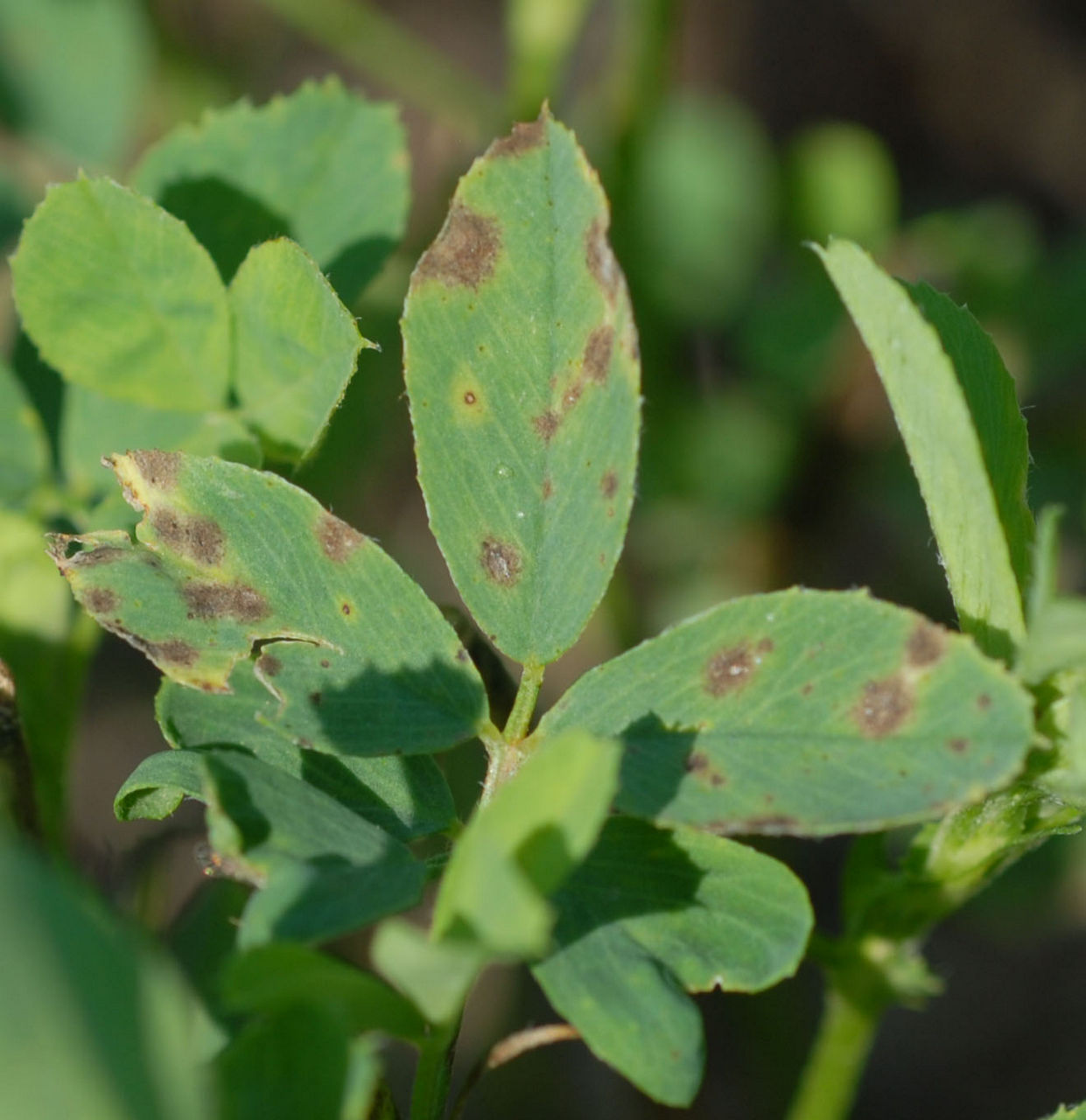
Type of Infection: Foliar and stem rot
Primary time of Infection: Mid-summer.
Symptoms:
Small, circular brown spots develop on both leaf surfaces.
Spots enlarge and become reddish to smoky brown, then turn ash gray to silvery (Figure 16).
Defoliation starts on the lower leaves and progresses up the stem.
Favorable Environment:
Warm to hot, humid weather.
More severe following the feeding of pea aphids and secretion of honeydew.
Overwinters in residue.
Can be seedborne.
Management:
Cut early if leaf drop becomes excessive.
Scout for pea aphid activity.
Verticillium Wilt (Verticillium albo-atrum)11
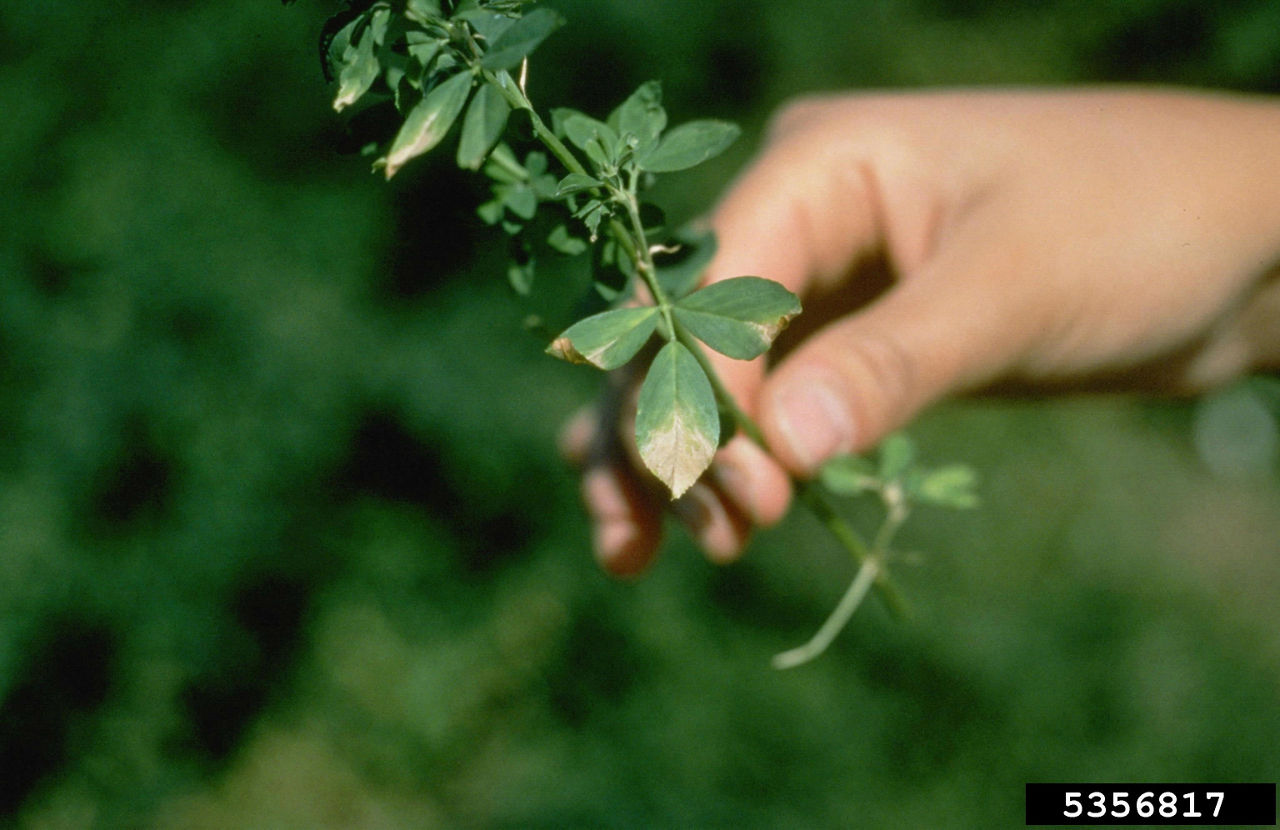
Type of Infection: Foliar, stem rot, and root rot.
Primary time of Infection: Mid-April to Early October.
Symptoms:
Initial infection includes V-shaped yellow or tan leaf tips (Figure 17).
Leaves become purple, tan, bleached, twisted, or dead.
Stems remain green.
Light brown ring develops inside taproot.
Dead plants.
Favorable Environment:
Overwinters in residue.
Can infect some weeds.
Can be seedborne.
Management:
Select resistant products.
Rotate to other crops for two to three years.
Control broadleaf weeds.
Clean equipment before leaving infected fields.
Foliar Diseases
Common Leaf Spot or Alfalfa Leaf Spot (Pseudopeziza medicaginis)14

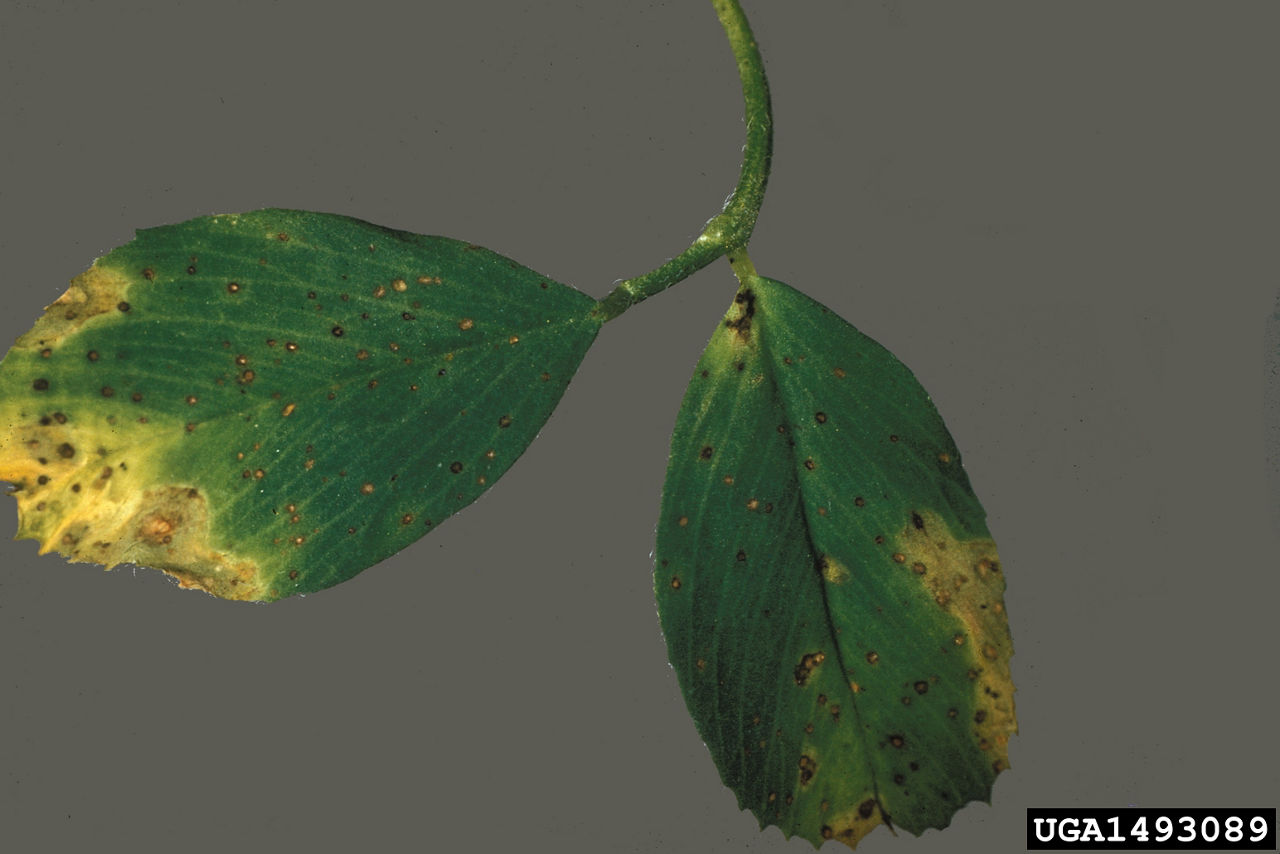
Type of Infection: Foliar.
Primary time of Infection: Anytime during the growing season under high moisture.
Symptoms:
Lower leaves develop small, dark brown to black circular spots. On the upper leaf surface, mature spots develop a light brown, raised fruiting body in the center of the spot that shoots microscopic spores into the air during cool to wet weather (Figure 18).
Leaves turn yellow on the upper leaf surface and drop.
Favorable Environment:
Prolonged periods of cool and wet weather.
Favors soils that are acid or low in fertility.
Overwinters in residue.
Management:
Cut early if leaf drop becomes excessive.
Downy Mildew (Peronospora trifoliorum)14

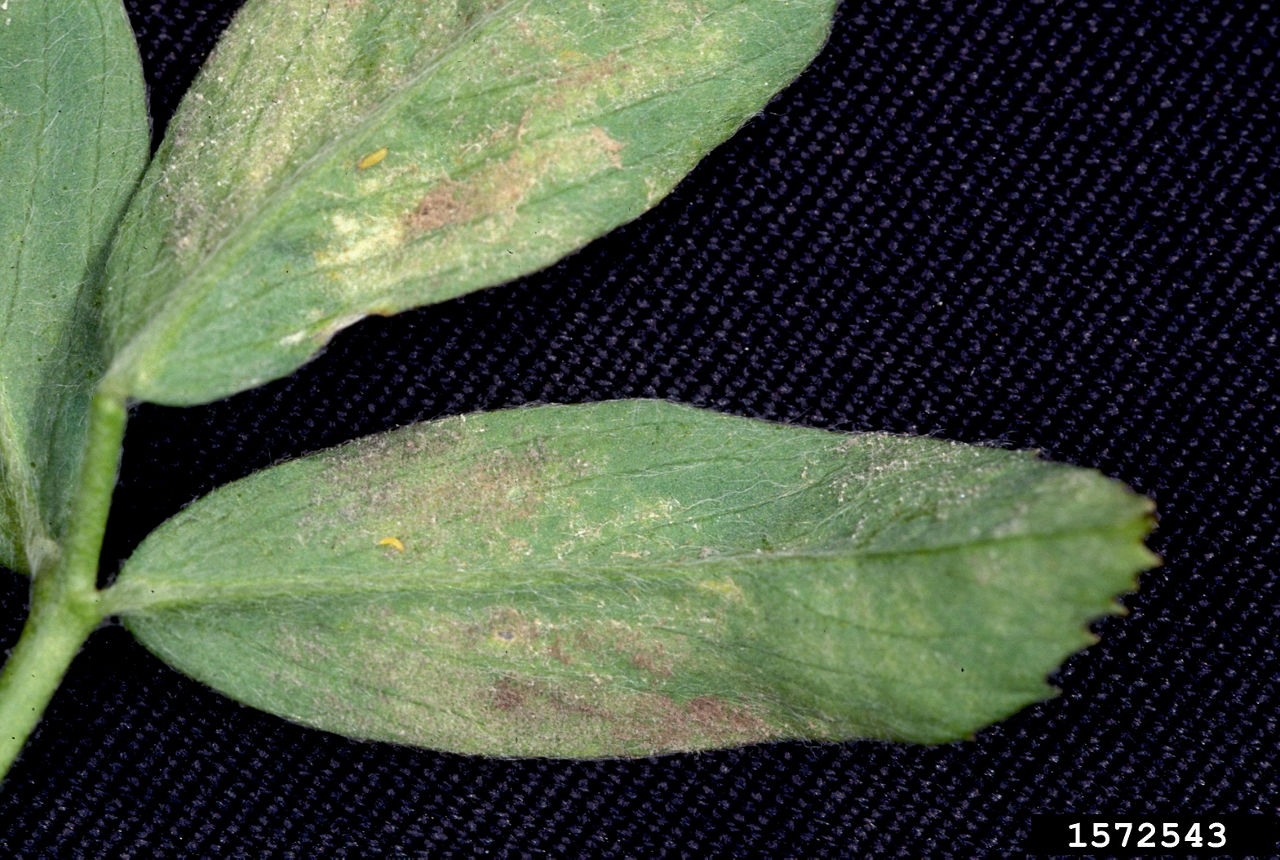
Type of Infection: Foliar.
Primary time of Infection: Mid-May through late June.
Symptoms:
Yellowish, green blotches on upper leaf surface.
White-gray mold growth on lower leaf surface (Figure 19).
Leaflets roll and twist downward.
Favorable Environment:
Cool (optimum 65°F), moist weather.
More severe first year following seeding.
Disappears during warm, dry weather.
Survives in infected crown buds and shoots.
Management:
Cut early if leaf drop becomes excessive.
Use fungicide treated seed if planting in late summer to early fall.
Leptosphaerulina Leaf Spot (Pepper Leaf Spot) (Leptosphaerulina briosiana)14

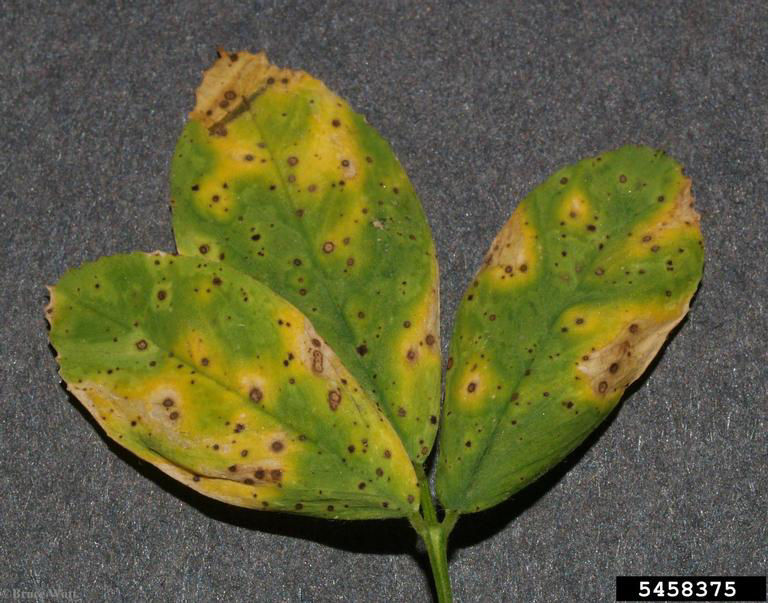
Type of Infection: Foliar.
Primary time of Infection: Mid-May through mid-June and late fall.
Symptoms:
Lesions start as small, black peppery spots which enlarge to form round to oval light brown spots with dark brown border and yellow halo (Figure 20).
Lesions may appear as large light tan to white lesions that encompass and kill the leaf under prolonged wet, cool conditions.
Favorable Environment:
Cool, wet weather.
Spores dispersed by wind.
Management:
Cut early if leaf drop becomes excessive.
Youngest leaves after harvest may show greatest damage.
Rust (Uromyces striatus medicaginis)14

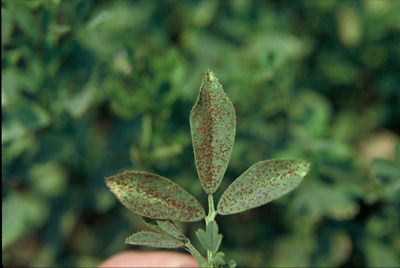
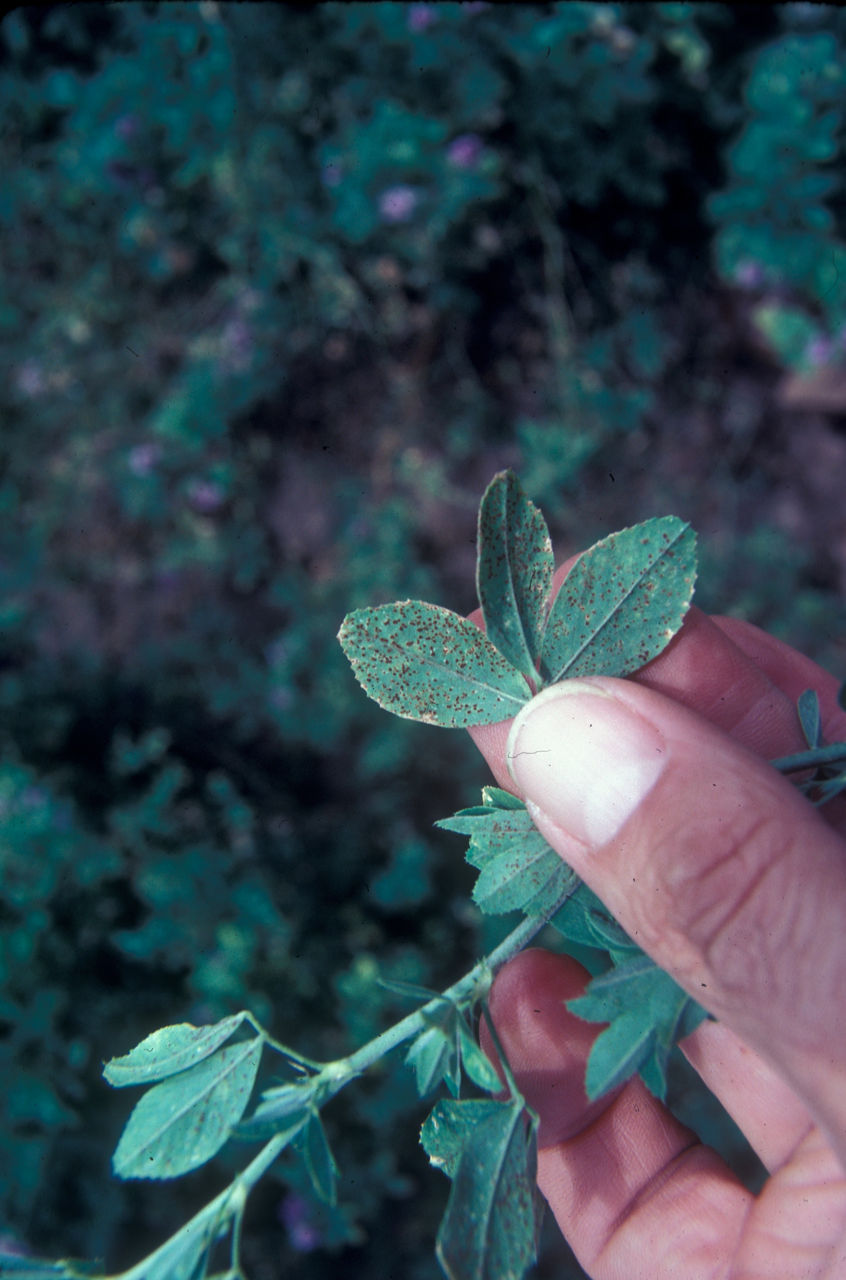
Type of Infection: Foliar.
Primary time of Infection: Usually occurs late-season.
Symptoms:
Small reddish-brown pustules on both leaf surfaces (mostly undersides) with brownish-orange spores (Figures 21 and 22).
Pustules may develop on petioles and stems.
Leaves may turn yellow, wither, and drop.
Favorable Environment:
Warm to hot, damp weather.
Builds up when third or fourth cutting is delayed.
Rank and lush growth.
Spores travel via wind from southern into northern states.
Management:
Timely cutting.
Stemphylium Leaf or Zonate Leaf Spot (Stemphylium botryosum)14,16

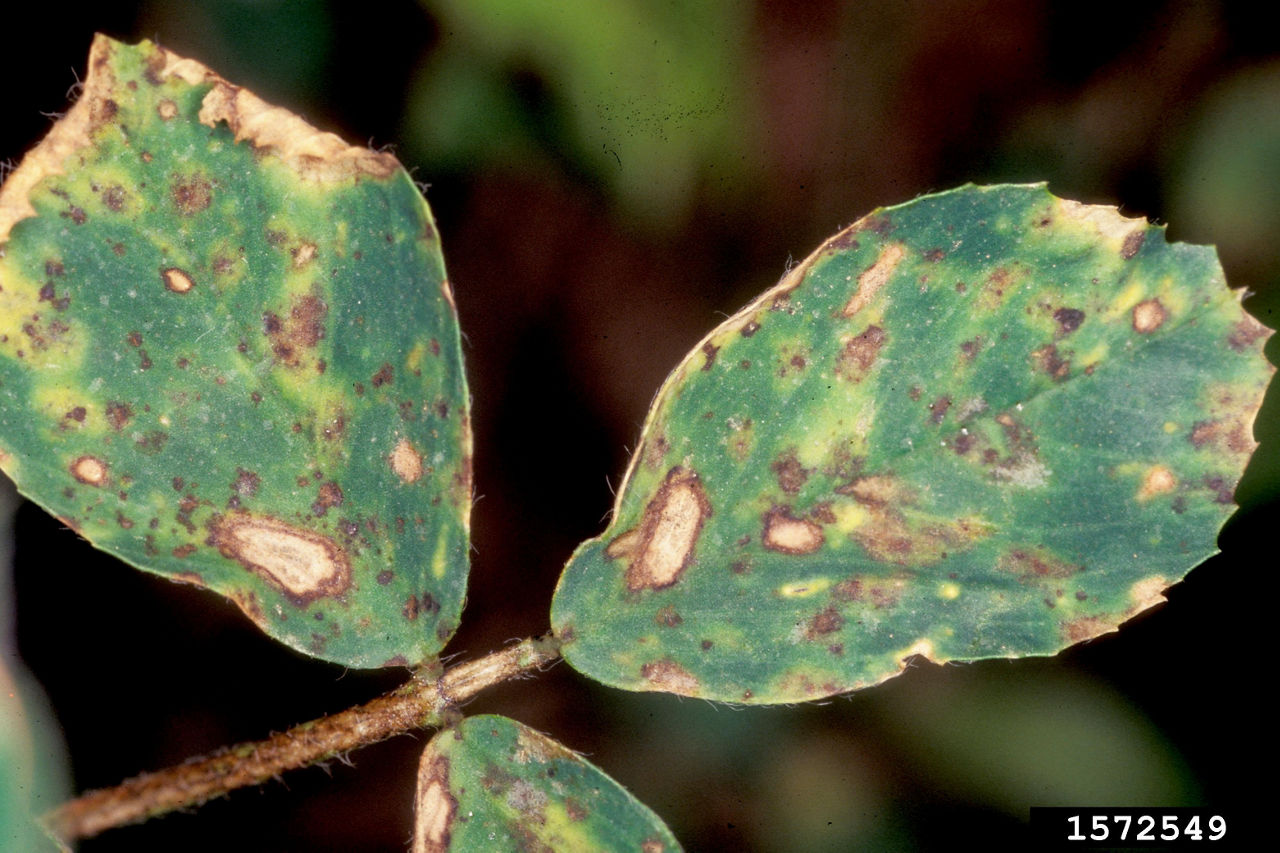
Type of Infection: Foliar.
Primary time of Infection: Summer and fall.
Symptoms:
Small, oval, sunken, dark spots on upper plant parts.
Spots enlarge and become zoned and bordered by a yellow halo (Figure 23).
Leaves turn yellow and drop.
Stems and petioles may have black areas and be girdled.
Favorable Environment:
Warm (60 to 70°F) and moist weather in summer and fall.
Overwinters on seed and residue.
Spread by water, wind, and infected seed.
Management:
Early harvest.
Yellow Leaf Blotch (Leptotrochila medicaginis)14

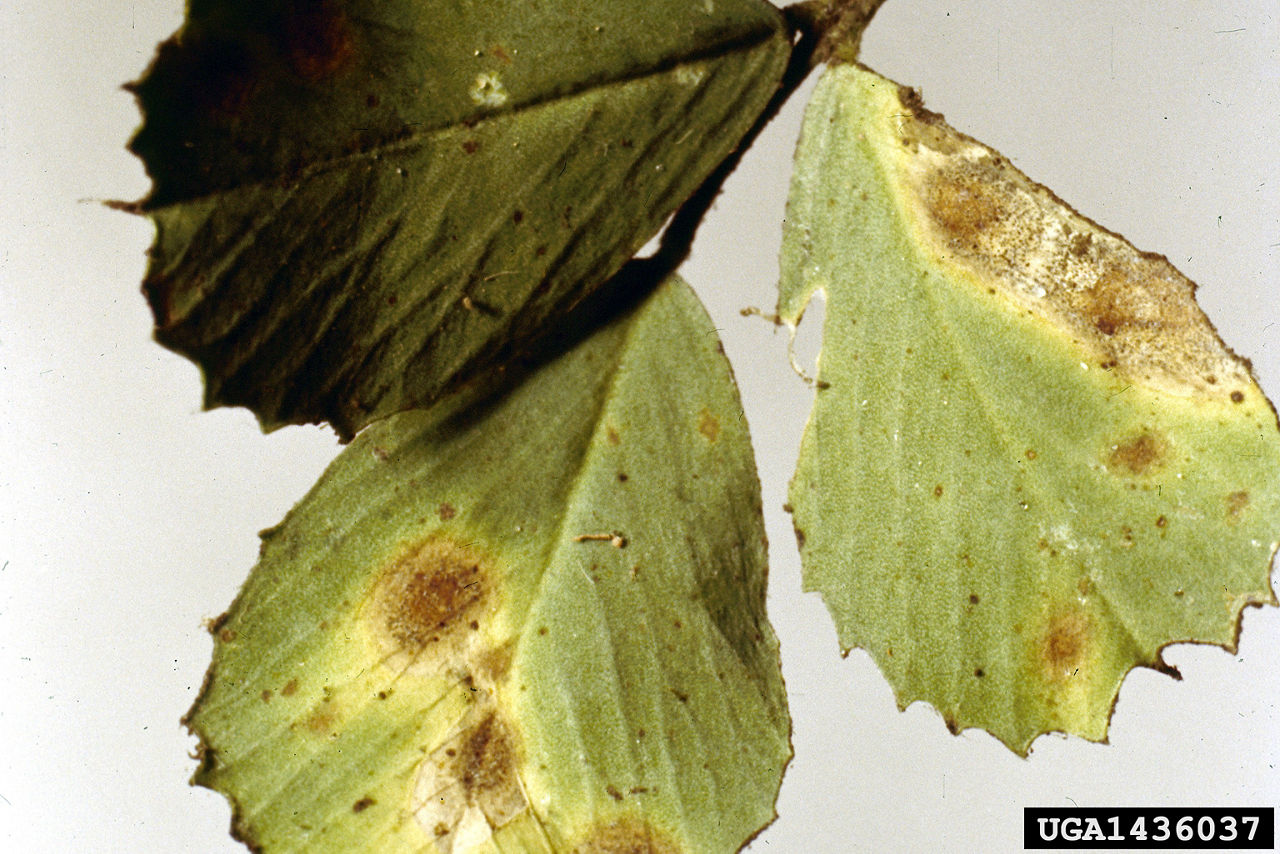
Type of Infection: Foliar.
Primary time of Infection: Spring and fall.
Symptoms:
Small yellow spots on upper leaf surface become elongated blotches parallel to the leaf veins (Figure 24).
Blotches contain numerous dark brown specks.
Favorable Environment:
Prolonged cool (optimum of 40 to 70°F), moist conditions.
Overwinters in residue.
Favors rank and tall plants.
Management:
Cut early if leaf loss is excessive.
Sources:
1 Samac, D. 2011. Alfalfa diseases 101: Diagnosing common & emerging disease problems. Forage Focus. United States Department of Agriculture.
2 Wells, M.S., Holen, D., and Sheaffer, C. 2018. Alfalfa establishment: Steps to maximize yield. University of Minnesota. https://extension.umn.edu/.
3 Lang, B. Is it profitable to use foliar fungicides in alfalfa production? Iowa State University. https://www.extension.iastate.edu/.
4 Aphanomyces root rot in alfalfa. Integrated Pest Management Programs. University of Kentucky. https://ipm.ca.uky.edu/.
5 Samac, D. 2009. Mycoleptodiscus crown and root rot of alfalfa: An emerging problem in Minnesota and Wisconsin. United States Department of Agriculture.
6 Groves, C. and Smith, D.L. 2013. Damping off and root rot of alfalfa caused by Phytophthora and Pythium. Integrated Pest and Crop Management. University of Wisconsin-Madison. https://ipcm.wisc.edu/.
7 Bessin, R. Phytophthora root rot in alfalfa. Integrated Pest Management Programs. University of Kentucky.
8 Wegulo, S.N. Phytophthora root rot of alfalfa. NebGuide G2078. University of Nebraska-Lincoln. https://extension.unl.edu/.
9 Vincelli, P. 2008. Alfalfa diseases caused by Rhizoctonia fungi. Plant Pathology Fact Sheet. PPFS-AG-F-06. University of Kentucky Cooperative Extension Service. https://plantpathology.ca.uky.edu/.
10 Babadoost, M. 1988. Bacterial wilt of alfalfa. Reports on Plant Diseases. RPD No. 300. University of Illinois.
11 Diseases of alfalfa wilts and rots. 2014. Management Guide. New York State Integrated Pest Management Program. Cornell Cooperative Extension. Cornell University. https://ecommons.cornell.edu/.
12 Wegulo, S. N. and Anderson, B.E. 2011. Alfalfa anthracnose. G2081. NebGuide. University of Nebraska-Lincoln. https://extension.unl.edu/.
13 Malvick, D.K. 2002. Sclerotinia crown and stem rot of alfalfa. The Bulletin. University of Illinois Extension. University of Illinois.
14 Malvick, D.K. 1988. Leaf and stem diseases of alfalfa. Report on Plant Disease. RPD No. 301. University of Illinois. https://ipm.illinois.edu/.
15 Wegulo, S.N. Spring and summer black stem and leaf spot diseases of alfalfa. NebGuide G2079. University of Nebraska-Lincoln. https://extension.unl.edu/.
16 Davis, R.M., Frate, C.A., and Putnam, D.H. 2017. Stemphylium leaf spot. Alfalfa. UC Pest Management Guidelines. How to Manage Pests. University of California.
Additional Source:
Samac, D.A., Rhodes, L.H. and Lamp, W.O. (Editors). 2015. Compendium of Alfalfa Diseases and Pests, Third Edition. The American Phytopathological Society (APS).
Web sites verified 2/19/21. 4023_S1
Seed Brands & Traits
Crop Protection
Disclaimers
- always read and follow pesticide label directions, insect resistance management requirements (where applicable), and grain marketing and all other stewardship practices. to review additional important information, click to open the menu below.expand_more
No dicamba may be used in-crop with seed with Roundup Ready® Xtend Technology, unless and until approved or specifically permitted, and no dicamba formulations are currently registered for such use in the 2024 season. Please follow www.roundupreadyxtend.com/xtendimaxupdates for status updates
Based on Court ruling and EPA Existing Stocks Order* on XtendiMax® Herbicide registration, Bayer has stopped its sale and distribution of XtendiMax® Herbicide. Visit our XtendiMax herbicide updates page to learn the latest www.roundupreadyxtend.com/xtendimaxupdates.
*Low-volatility dicamba products subject to the ruling include XtendiMax® herbicide with VaporGrip® Technology, Engenia® herbicide and Tavium® Plus VaporGrip® Technology herbicide.
The Preceon™ Smart Corn System, including short stature corn developed through traditional breeding, is expected to be available, subject to final commercialization decisions, for planting in the 2024 growing season.
Short stature corn developed through biotechnology is not currently available for commercial sale or commercial planting. Commercialization is dependent on multiple factors, including successful conclusion of the regulatory process.
This material may contain “forward-looking statements” based on current assumptions and forecasts made by Bayer management. Various known and unknown risks, uncertainties and other factors could lead to material differences between the actual future results, financial situation, development or performance of the company and the estimates given here. These factors include those discussed in Bayer’s public reports which are available on the Bayer website at www.bayer.com. The company assumes no liability whatsoever to update these forward-looking statements or to conform them to future events or developments.
*Commercialization is dependent on multiple factors, including successful conclusion of the regulatory process. The information presented herein is provided for educational purposes only, and is not and shall not be construed as an offer to sell, or a recommendation to use, any unregistered pesticide for any purpose whatsoever. It is a violation of federal law to promote or offer to sell an unregistered pesticide.
Bayer is a member of Excellence Through Stewardship® (ETS). Bayer products are commercialized in accordance with ETS Product Launch Stewardship Guidance, and in compliance with Bayer’s Policy for Commercialization of Biotechnology-Derived Plant Products in Commodity Crops. Commercialized products have been approved for import into key export markets with functioning regulatory systems. Any crop or material produced from this product can only be exported to, or used, processed or sold in countries where all necessary regulatory approvals have been granted. It is a violation of national and international law to move material containing biotech traits across boundaries into nations where import is not permitted. Growers should talk to their grain handler or product purchaser to confirm their buying position for this product. Excellence Through Stewardship® is a registered trademark of Excellence Through Stewardship.
XtendiMax® herbicide with VaporGrip® Technology has been classified as pesticide and must be used with VaporGrip® Xtra Agent (or an equivalent volatility reduction adjuvant). For approved tank-mix products (including VRAs and DRAs), nozzles and other important label information visit XtendiMaxApplicationRequirements.com. Applicators must check XtendiMaxApplicationRequirements.com no more than 7 days before application of this product for additional labeling, including state restrictions. Where applicable, users must comply with additional requirements found on this website.
ALWAYS READ AND FOLLOW PESTICIDE LABEL DIRECTIONS. Not all products are registered for use in all states and may be subject to use restrictions. The distribution, sale, or use of an unregistered pesticide is a violation of federal and/or state law and is strictly prohibited. Check with your local dealer or representative for the product registration status in your state.
Product Use Statement: Enlist E3® soybeans contain the Enlist E3 trait that provides crop safety for use of labeled over-the-top applications of glyphosate, glufosinate and 2,4-D herbicides featuring Colex-D® technology when applied according to label directions. Following burndown, the only 2,4-D containing herbicide products that may be used with Enlist® crops are products that feature Colex-D technology and are expressly labeled for use on Enlist crops. 2,4-D products that do not contain Colex-D technology are not authorized for use in conjunction with Enlist E3 soybeans. Warning: Enlist E3 soybeans are tolerant of over-the top applications of glyphosate, glufosinate, and 2,4-D. Accidental application of incompatible herbicides to this variety could result in total crop loss. When using 2,4-D herbicides, grower agrees to only use 2,4-D products that contain Colex-D technology authorized for use in conjunction with Enlist E3 soybeans. Always read and follow herbicide label directions prior to use.
YOU MUST SIGN A TECHNOLOGY AGREEMENT, READ THE PRODUCT USE GUIDE PRIOR TO PLANTING AND FOLLOW HERBICIDE RESISTANCE MANAGEMENT (HRM) REQUIREMENTS.
The transgenic soybean event in the Enlist E3® soybeans is jointly developed and owned by Corteva Agriscience and M.S. Technologies, L.L.C. ®™ Enlist, Enlist E3, the Enlist E3 logo and Colex-D are trademarks Corteva Agriscience and its affiliate companies.
Alloy™ and Connect™ are trademarks of M.S. Technologies, L.L.C., West Point, IA. Please read the M.S. Technologies, L.L.C. Use Restriction Agreement located at: - http://www.mstechseed.com/use-restriction-agreement/.
ALWAYS READ AND FOLLOW PESTICIDE LABEL DIRECTIONS. FOR COTTON TREATED FOR MARKET YEAR 2024, EACH ACCELERON® SEED APPLIED SOLUTIONS OFFERING is a combination of separate individually registered products containing the active ingredients: BASIC Offering: fluoxastrobin, prothioconazole, metalaxyl, myclobutanil, and penflufen. STANDARD Offering: fluoxastrobin, prothioconazole, metalaxyl, myclobutanil, penflufen, and imidacloprid. ELITE plus Copeo® Offering: fluoxastrobin, prothioconazole, metalaxyl, myclobutanil, penflufen, imidacloprid, and fluropyram.
FOR COTTON TREATED FOR MARKET YEAR 2022 OR PRIOR, EACH ACCELERON® SEED APPLIED SOLUTIONS OFFERING is a combination of separate individually registered products containing the active ingredients: BASIC Offering: fluxapyroxad, pyraclostrobin, metalaxyl, and myclobutanil. STANDARD Offering: fluxapyroxad, pyraclostrobin, metalaxyl, myclobutanil, and imidacloprid. ELITE plus Poncho®/VOTiVO® Offering: fluxapyroxad, pyraclostrobin, metalaxyl, myclobutanil, imidacloprid, clothianidin, and Bacillus Firmus I-1582.
Please review each seed tag to determine active ingredients in the product offering on the seed. The distribution, sale, or use of an unregistered pesticide is a violation of federal and/or state law and is strictly prohibited. Not all products are approved in all states.
ALWAYS READ AND FOLLOW PESTICIDE LABEL DIRECTIONS. FOR SOYBEANS SEED TREATMENT PRODUCTS APPLIED DOWNSTREAM, EACH ACCELERON® SEED APPLIED SOLUTIONS OFFERING is a combination of separate individually registered products containing the active ingredients: BASIC Offering: metalaxyl, penflufen and prothioconazole. STANDARD Offering: metalaxyl, penflufen, prothioconazol and imidacloprid. FOR UPSTREAM TREATED SOYBEANS, EACH ACCELERON® SEED APPLIED SOLUTIONS OFFERINGis a combination of separate individually registered products containing the active ingredients: BASIC Offering: metalaxyl, fluxapyroxad, and pyraclostrobin. STANDARD Offering: metalaxyl, fluxapyroxad, pyraclostrobin and imidacloprid. The distribution, sale, or use of an unregistered pesticide is a violation of federal and/or state law and is strictly prohibited. Not all products are approved in all states.
ALWAYS READ AND FOLLOW PESTICIDE LABEL DIRECTIONS. FOR CORN, EACH ACCELERON® SEED APPLIED SOLUTIONS OFFERING is a combination of separate individually registered products containing the active ingredients: BASIC plus Poncho®/VOTiVO® Offering for corn: metalaxyl, ethaboxam, prothioconazole, fluoxastrobin, clothianidin, Bacillus firmus I-1582. ELITE plus Poncho®/VOTiVO® Offering for corn: metalaxyl, ethaboxam, clothianidin, and Bacillus firmus I-1582; prothioconazole and fluoxastrobin at rates that suppress additional diseases. BASIC Offering for corn: metalaxyl, prothioconazole, fluoxastrobin, ethaboxam, and clothianidin. ELITE Offering for corn: metalaxyl, ethaboxam, and clothianidin; and prothioconazole and fluoxastrobin at rates that suppress additional diseases. BioRise® Corn Offering is included seamlessly across offerings on all class of 2017 and newer products. The distribution, sale, or use of an unregistered pesticide is a violation of federal and/or state law and is strictly prohibited. Not all products are approved in all states.
Performance may vary, from location to location and from year to year, as local growing, soil and weather conditions may vary. Growers should evaluate data from multiple locations and years whenever possible and should consider the impacts of these conditions on the grower’s fields.
The Bayer Carbon Program described in this material is subject to the current version of the Bayer Carbon-Smart Practices Master Agreement. The information is to aid in the understanding of the Bayer Carbon Program and does not change or modify the Bayer Carbon-Smart Practices Master Agreement in any way.
The RRXtend Spray App provides forecasts for locations within the contiguous United States. Do not use this app for forecasts outside the contiguous United States. Forecasts are for planning purposes only and are not a substitute for checking actual weather conditions at your location at the time of application and comply with the product label and other legal requirements.
B.t. products may not yet be registered in all states. Check with your seed brand representative for the registration status in your state.
Refuge seed may not always contain the DroughtGard® trait. Adament™ 50 WG Fungicide is only registered in California. Roundup Technology® includes glyphosate-based herbicide technologies.
IMPORTANT IRM INFORMATION: Certain products are sold as RIB Complete® corn blend products, and do not require the planting of a structured refuge except in the Cotton-Growing Area where corn earworm is a significant pest. Products sold without refuge in the bag (non-RIB Complete) require the planting of a structured refuge. See the IRM/Grower Guide for additional information. Always read and follow IRM requirements.
ONLY USE FORMULATIONS THAT ARE SPECIFICALLY LABELED FOR SUCH USES AND APPROVED FOR SUCH USE IN THE STATE OF APPLICATION. Contact the U.S. EPA and your state pesticide regulatory agency with any questions about the approval status of dicamba herbicide products for in-crop use with products with XtendFlex® Technology.
ALWAYS READ AND FOLLOW PESTICIDE LABEL DIRECTIONS. It is a violation of federal and state law to use any pesticide product other than in accordance with its labeling. NOT ALL formulations of dicamba or glyphosate are approved for in-crop use with Roundup Ready 2 Xtend® soybeans. NOT ALL formulations of dicamba, glyphosate or glufosinate are approved for in-crop use with products with XtendFlex® Technology.
Roundup Ready® Technology contains genes that confer tolerance to glyphosate. Roundup Ready® 2 Technology contains genes that confer tolerance to glyphosate. LibertyLink® Technology contains genes that confer tolerance to glufosinate. Roundup Ready® Flex Technology contains genes that confer tolerance to glyphosate. Roundup Ready technology contains genes that confer tolerance to glyphosate, an active ingredient in Roundup® brand agricultural herbicides. Roundup Ready 2 Xtend® soybeans contain genes that confer tolerance to glyphosate and dicamba. Products with XtendFlex® Technology contains genes that confer tolerance to glyphosate, glufosinate and dicamba. Plants that are not tolerant to glyphosate, dicamba, and/or glufosinate may be damaged or killed if exposed to those herbicides. Contact your seed brand dealer or refer to the Bayer Technology Use Guide for recommended weed control programs.
Insect control technology provided by Vip3A is utilized under license from Syngenta Crop Protection AG. Movento® MPC Insecticide is only registered for use in Florida, Georgia and Alabama. Aeris®, Balance® Flexx, Baythroid® XL, Corvus®, Degree Xtra®, Harness® Xtra 5.6L Herbicide, Harness® Xtra Herbicide, Huskie® Complete, Leverage® 360, and TriVolt™ are restricted use pesticides. Not all products are registered for use in all states and may be subject to use restrictions. The distribution, sale, or use of an unregistered pesticide is a violation of federal and/or state law and is strictly prohibited. Check with your local dealer or representative for the product registration status in your state. Fortenza Advanced™ is an on-seed application of Fortenza® and Rascendo® seed treatments. Agrisure Viptera®, Fortenza Advanced™, Fortenza® and Rascendo® are trademarks of Syngenta Group Company. Tank mixtures: The applicable labeling for each product must be in the possession of the user at the time of application. Follow applicable use instructions, including application rates, precautions and restrictions of each product used in the tank mixture. Not all tank mix product formulations have been tested for compatibility or performance other than specifically listed by brand name. Always predetermine the compatibility of tank mixtures by mixing small proportional quantities in advance. Degree® is a registered trademark of Monsanto Technology LLC. Channel®, Channel® and the Arrow Design® and Seedsmanship At Work® are registered trademarks of Channel Bio, LLC. Services and products offered by Climate LLC are subject to the customer agreeing to our Terms of Service. Our services provide estimates or recommendations based on models. These do not guarantee results. Consult with your agronomist, commodity broker, or other industry professional before making financial, farming, or risk management decisions. More information at www.climate.com/legal/disclaimer. FieldView™ is a trademark of Climate LLC. Herculex® is a registered trademark of Dow AgroSciences LLC. Clearfield®, Copeo®, ILeVO®, LibertyLink logo® , LibertyLink®, Poncho®, Poncho®/Votivo® and Votivo® are trademarks of BASF Corporation. Respect the Refuge and Corn Design® and Respect the Refuge® are registered trademarks of National Corn Growers Association. Some of the product(s) discussed herein are restricted use pesticide(s) and may not be registered in all states. The distribution, sale, or use of an unregistered pesticide is a violation of federal and/or state law and is strictly prohibited. Check with your local dealer or product representative for the product registration status in your state. Absolute®, Acceleron®, Adament™, Admire®, Aeris®, Aliette®, Alion®, Allegiance®, Asgrow and the A Design®, Asgrow®, Autumn™, Axiom®, Balance®, Bayer, Bayer Cross, Baythroid®, BioRise®, Bollgard II®, Bollgard®, BUTEO™ start, Capreno®, ConnectIN™, Corn States Triangle Design®, Corvus®, Degree Xtra®, DEKALB and Design®, DEKALB®, Delaro®, Deltapine Select™, Deltapine®, DiFlexx®, Disease Shield®, DroughtGard®, DryTough™, Emesto®, Evergol®, EverGol®, FarmFlex®, Finish®, Flint®, Fontanelle Hybrids and Design®, Fontanelle Hybrids®, Gaucho®, Gem®, Ginstar®, Gold Country Seed®, Ground Breakers®, H Hubner and Design™, Harness®, Hubner Seed & Design®, Hubner Seed Your Trustworthy Seed Resource & Design®, Hubner Seed™, Huskie®, Jung Seed Genetics & Design®, Jung Seed Genetics™, Kruger Seeds™, Laudis® , Leaf Triangle Design®, Leverage®, Lewis Hybrids and Design®, Lewis Hybrids™ , Lewis Premium Grains & Design®, Luna Experience®, Luna Privilege®, Luna Sensation®, Luna Tranquility®, Luna® Flex, Luna® Pro Fungicide, Luxxur®, MILK MAXX SILAGE RESEARCH and Design®, Minuet™, Movento®, Movento® HL, Nortron®, Oberon®, Olympus®, Poncho®, Preceon™, Proline®, Propulse®, Prosaro®, Prosper®, Provost®, Raxil®, REA Hybrids and Design™, Rea Hybrids™ , Respect the Refuge and Cotton Design®, RIB Complete and Design®, RIB Complete®, Ricestar®, Rimfire®, Roundup PowerMAX®, Roundup Ready 2 Technology and Design®, Roundup Ready 2 Xtend®, Roundup Ready 2 Yield®, Roundup Ready®, Roundup Technology®, Roundup WeatherMAX and Design®, Roundup WeatherMAX®, Roundup®, RT 3 Powered by Roundup Technology and Design®, RT 3®, Scala®, Serenade®, Serenade® SOIL fungicide, SilageSmart & Design®, SilageSmart®, Sivanto®, SmartStax®, Specialty and Design®, Specialty Hybrids™, SR and Design®, Stance®, Stewart and Design™, Stewart Seeds™, Stone Seed & Design™, Stone Seed™, Stratego®, ThryvOn™, Trecepta®, Trilex®, TripleFLEX®, TriVolt™, TruFlex™, VaporGrip®, Varro®, Velum®, Vistive®, VT Double PRO®, VT Triple PRO®, VT4PRO™, VT4PRO™ , Warrant®, WestBred and Design®, WestBred®, Wolverine®, XtendFlex®, XtendiMax® and YieldGard VT PRO® are trademarks of Bayer Group. All other trademarks are the property of their respective owners. For additional product information call toll-free 1-866-99-BAYER (1-866-992-2937) or visit our website at www.BayerCropScience.us. Bayer CropScience LP, 800 North Lindbergh Boulevard, St. Louis, MO 63167. ©2024 Bayer Group. All rights reserved.







©2023 Bayer Group. All rights reserved.